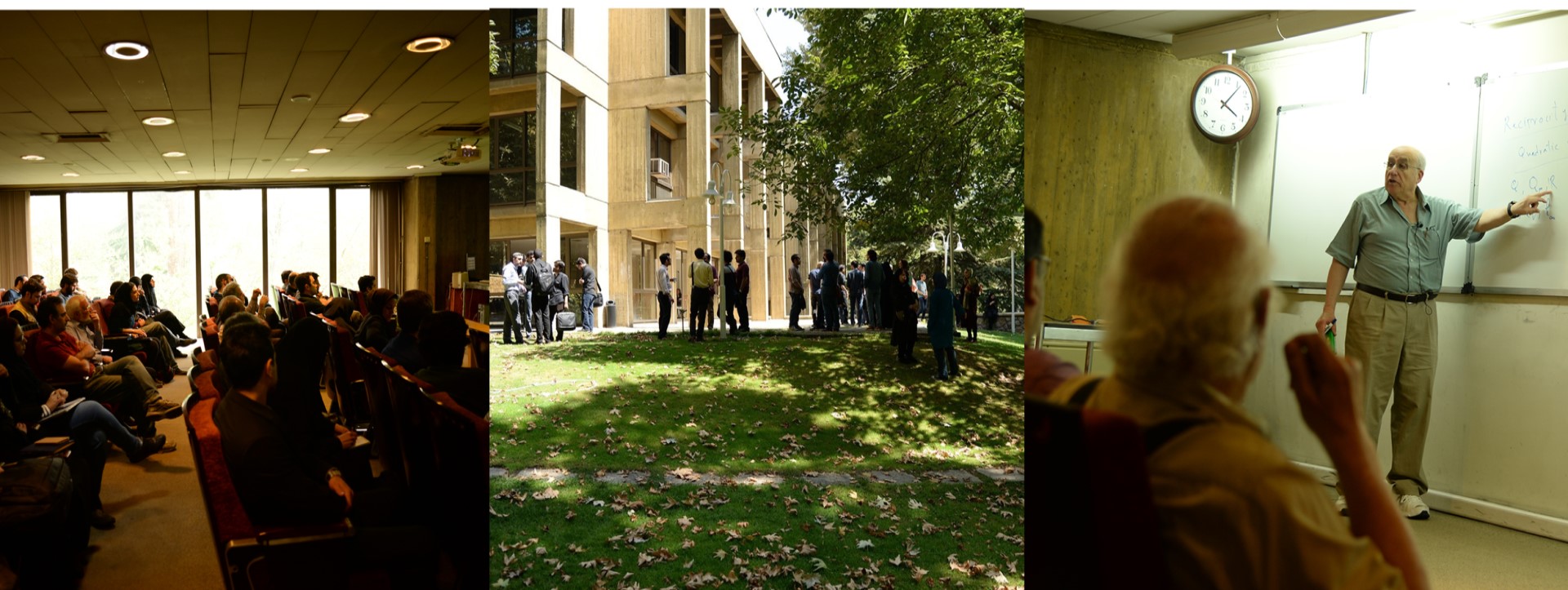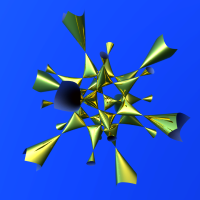
IPM Algebraic Geometry Seminar
IPM is holding a biweekly zoom Algebraic Geometry seminar for Winter/Spring 2024.

Where: Zoom
Meeting ID: 908 611 6889
Passcode: 13440 × the number of lines on a cubic surface
Seminar mailing list: google group
Poster: here
Talks
Speaker: Emilia Mezzetti, University of Trieste (Italy)
Title: Hilbert functions, Lefschetz properties and Perazzo hypersurfaces
Abstract: Artinian Gorenstein algebras (AG algebras for short) can be viewed as algebraic analogues
of the cohomology rings of smooth projective varieties. The Strong and Weak Lefschetz properties for graded AG
algebras take origin from the hard Lefschetz theorem. The properties of an AG quotient $A _F$ of a polynomial ring
are related to its Macaulay dual generator $F$, and in particular $A_F$ fails the Strong Lefschetz property if and
only if the hessian of $F$ of order $t$ vanishes for some $1\leq t\leq d/2$, where $d=\deg F$ and the usual hessian is obtained for $t=1$.
Perazzo polynomials are a large class of polynomials with vanishing hessian so their algebras $A_F$ always
fail the SLP. I will report on some recent results concerning the question if the WLP holds for these algebras.
Joint work with N. Abdallah, N. Altafi, P. De Poi, L. Fiorindo, A. Iarrobino, P. Macias Marques, R.M. Mir ́o-Roig, L. Nicklasson.
Date: June 12, 2024
Video link
Passcode: pAL!a3&2
Speaker: Jonas Stelzig, LMU Munich (Germany)
Title: Linear combinations of cohomological invariants of compact complex manifolds
Abstract: In the 50s, Hirzebruch asked which linear combinations of Hodge and
Chern numbers are topological invariants of compact complex manifolds.
Building on ideas of Schreieder and Kotschick, who solved the Kähler
case, I will present a general answer to this question (and some related
ones). Furthermore, I will outline a program how to tackle similar
questions when incorporating more cohomological invariants, eg the
dimensions of the Bott Chern cohomology groups. This will naturally lead
to an algebraic study of the structure of bicomplexes, as well as a
number of challenging geometric construction problems.
Date: May 29, 2024
Video link
Passcode: 5.Sa?rT4
Speaker: Rita Pardini, University of Pisa (Italy)
Title: Exploring the boundary of the moduli space of stable surfaces: some explicit examples
Abstract: I will briefly recall the notion of stable surfaces and of the corresponding moduli space. Then
I will outline a partial description of the boundary points in the case
of surfaces with $K^2=1$, $p_g=2$ (joint work with Stephen Coughlan, Marco Franciosi,
Julie Rana and Soenke Rollenske, in various combinations) and, time permitting, in the case of Campedelli and Burniat surfaces (joint work with Valery Alexeev).
Date: May 15, 2024
Video link
Passcode: *4HOABbc
Speaker: Razieh Ahmadian, Shahid Beheshti University (Iran)
Title: Hironaka's Question F and its Simplification
Abstract: A special case of Hironaka's QUESTION F, named F', asks about the strong
factorization of birational maps between reduced nonsingular algebraic schemes, which is still open. Suppose
that $\varphi : X\dashrightarrow Y$ is such a map, and let $U\subset X$ be the open subset where $\varphi$ is an isomorphism. This problem asks if there exists a diagram
$$
\xymatrix{ & Z \ar[dl]_{\varphi_{1}}\ar[dr]^{\varphi_{2}}\\
X \ar[rr]^{\varphi} & & Y}
$$
where the morphisms $\varphi_{1}$ and $\varphi_{2}$ are sequences of blow-ups of non-singular centers disjoint
from $U$. In this talk, we will discuss how strong factorization can be simplified by providing a complete answer to
the problem of toroidalization of morphisms, while we introduce the strong Oda conjecture.
Date: May 1, 2024
Speaker: Victoria Hoskins, Radboud University Nijmegen (Netherlands)
Title: Motives of stacks of bundles and sheaves on curves
Abstract: The geometry of moduli spaces and stacks of vector bundles on curves
have been intensively studied from different perspectives; for example,
via point counting over finite fields by Harder and Narasimhan, and
gauge theoretically by Atiyah and Bott over the complex numbers.
Following Grothendieck’s vision that a motive of an algebraic variety
should capture many of its cohomological invariants, Voevodsky
introduced a triangulated category of motives which partially realises
this idea. After describing some properties of this category, I will
present a formula for the motive of the moduli stack of vector bundles
on a smooth projective curve; this formula is compatible with classical
computations of invariants of this stack due to Harder, Atiyah--Bott and
Behrend--Dhillon. The proof involves rigidifying this stack using
Flag-Quot schemes parametrising Hecke modifications as well as a motivic
version of an argument of Laumon and Heinloth on the cohomology of small
maps, which is closely related to the Grothendieck-Springer resolution.
I will explain how to extend this to a formula for the stack of coherent
sheaves and, if there is time, I will give an overview of other motivic
descriptions of closely related moduli spaces. This is joint work with
Simon Pepin Lehalleur.
Date: April 17, 2024
Video link
Passcode: Sr4!XT6f
Speaker: Simon Pepin Lehalleur, University of Amsterdam (Netherlands)
Title: Cohomology and motives of moduli spaces of Higgs bundles and motivic mirror symmetry
Abstract: Higgs bundles are vector bundles equipped with an
additional "twisted endomorphism". Introduced by Nigel Hitchin in a context of mathematical physics,
they have turned to be central objects in differential and algebraic geometry. In particular, moduli spaces
of Higgs bundles have a very rich geometry that is both related to the geometry of moduli of vector bundles
but also has additional symplectic features. I will introduce these moduli spaces and discuss some of what
is known about their cohomology and their motivic invariants. There has been a lot of recent progress
in this direction and I will try to describe the main threads. I will conclude with a discussion of my
joint work with Victoria Hoskins on a motivic version of the "cohomological mirror symmetry" conjecture of Hausel and Thaddeus for SL_n and PGL_n Higgs bundles.
Date: February 28, 2024
Video link
Passcode: $2c%g*XF